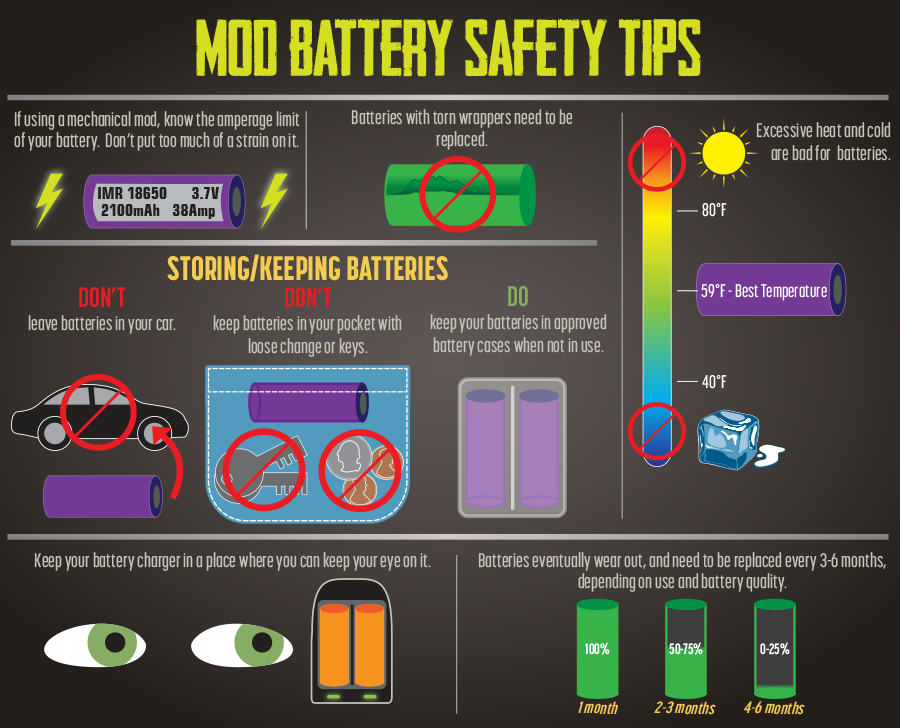
Vape Batteries are not like your remote-control batteries: they are much more powerful cells that need to be handled carefully. If you own a regulated vape mod that is powered by batteries such as 18650s or 20700s, this Battery Safety Resource Page is for you.
Keep Wraps Intact
Always make sure that the wraps of your batteries are in pristine condition. If you notice a nick on the battery wrap, the safe thing to do is to re-wrap it. Battery wraps are cheap and very easy to put on. If you don’t have wraps, visit your local vape shop. Most shops will wrap your batteries for free and it won’t take more than a couple of minutes to do. Check out Dash Vapes’ video below on how to quickly and easily rewrap your batteries.
Use The Right Batteries
Some batteries are better for low wattage vaping, others are better for sub-ohming, and others are not supposed to be used for vaping at all. When picking batteries for your mod, make sure that they come in the appropriate specs. Don’t just read the numbers on the wraps, as those are often misleading. For more information, check our best vape batteries pages.
Use Battery Cases
Never throw batteries in pockets or bags when not in use. Get yourself some cheap plastic battery cases instead, as unprotected batteries might short circuit when they come in contact with metal objects. This may cause your battery to vent and potentially explode.
Watch Out For Counterfeits
Counterfeit batteries are unfortunately a thing, with the big three (Sony, Samsung, Panasonic) being the most commonly counterfeited brands due to their higher price tag. Always buy batteries from reputable vendors, as those will go out of their way to make sure their batteries are originals.
Don’t Leave Your Batteries Charging Unattended
Even when using a charger, having your batteries charging unattended is never a good idea, especially overnight. Although very rare, battery chargers are electronic devices and failures are not unheard of. Always keep an eye on your charging batteries and place them in battery cases when you are not around.
Use a Dedicated Charger
Charging your batteries directly in your mod is possible with most devices nowadays, but it’s always safer to use a dedicated battery charger. A simple charger can cost less than a 60 mL bottle of e-juice! Stepping up a bit in price will add features such as battery data and health monitoring.
Don’t Over-drain Your Batteries
If possible, try to not completely drain your batteries — lithium-ion batteries tend to lose more capacity the further you let them discharge. Most mods will come with some form of battery level indication. Taking your batteries out to charge before they are completely drained will prolong their life, i.e. the amount of cycles you will be able to get out of them.
Avoid Extreme Temperatures
Vape batteries can tolerate low and high temperatures, but you wouldn’t want to test their limits. Higher temperatures will strain your batteries, making them age faster (or even vent), while colder temperatures take a toll on battery capacity. Make sure you store them in a cool place away from sunlight and never ever leave them stored in places like the glove compartment of your car where temperatures might even exceed their safety range. If you live in an area where the temperatures frequently get extreme, consider carrying your vape device and batteries in a small insulated lunch cooler.
Use Married Batteries
If you are using a mod that takes more than one battery, always use the exact same batteries (for example, a pair of Sony VTC5s) and keep them married, i.e. use them in pairs and always together — it’s a safe practice. This will ensure that the cells get the same number of charges/discharges and help delay imbalances in capacity and performance.
Replace Old Batteries
Batteries are only good up to a certain amount of cycles (full charge to full discharge). Lithium-ion batteries will start losing capacity and strength when used extensively for longer periods of time. If you sense that your battery takes less time to discharge, just replace it. Even if you haven’t noticed something out of the ordinary, replace your batteries after six months to a year, depending on how often you use them.
Recycle Old Batteries
When replacing old batteries, always recycle them instead of throwing them away. A lithium-ion cell can easily short-circuit in the trash can, which is a serious hazard risk. On top of that, recycling batteries is good for the environment. Keep an eye for battery disposal boxes and follow safety instructions when recycling your old batteries.
